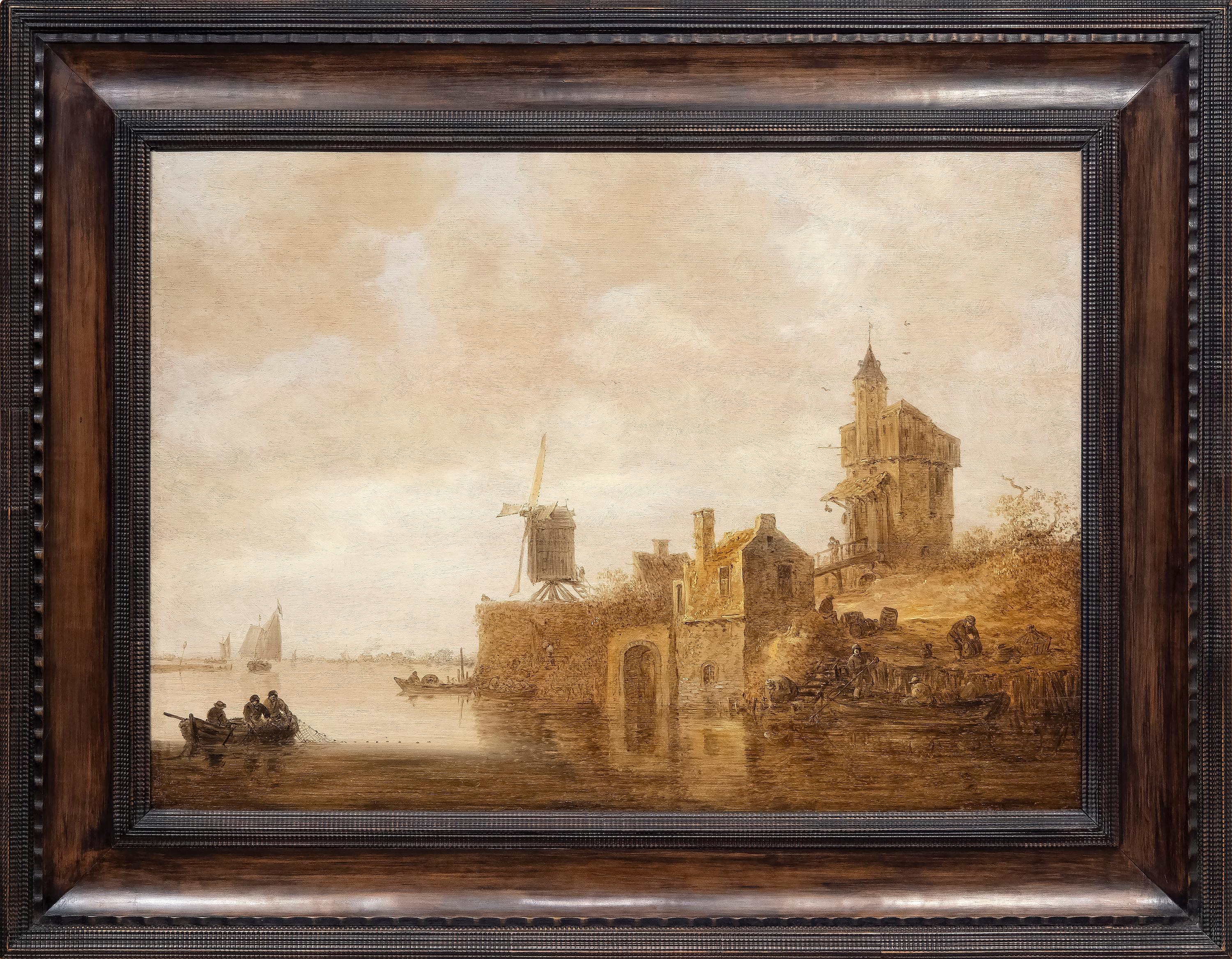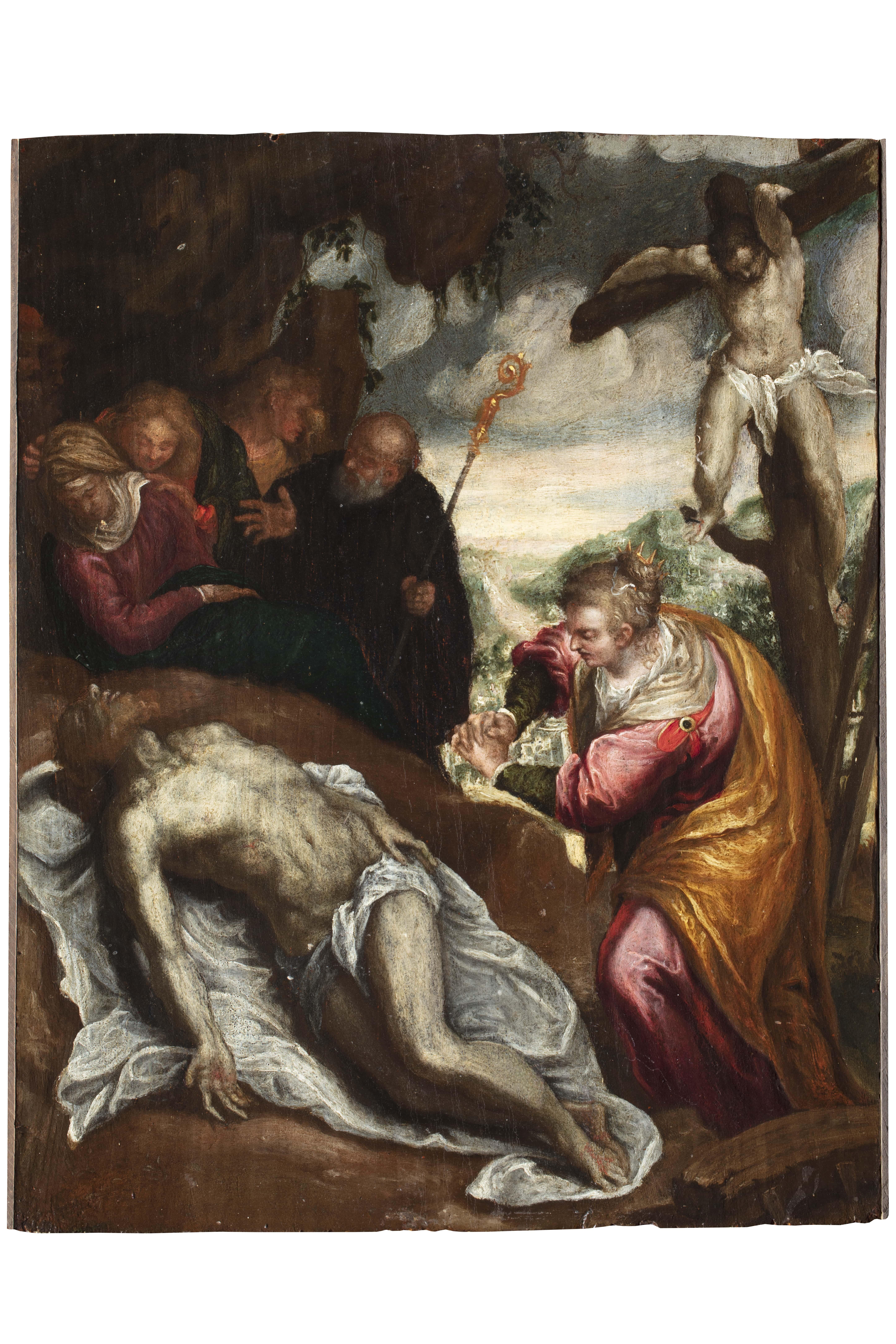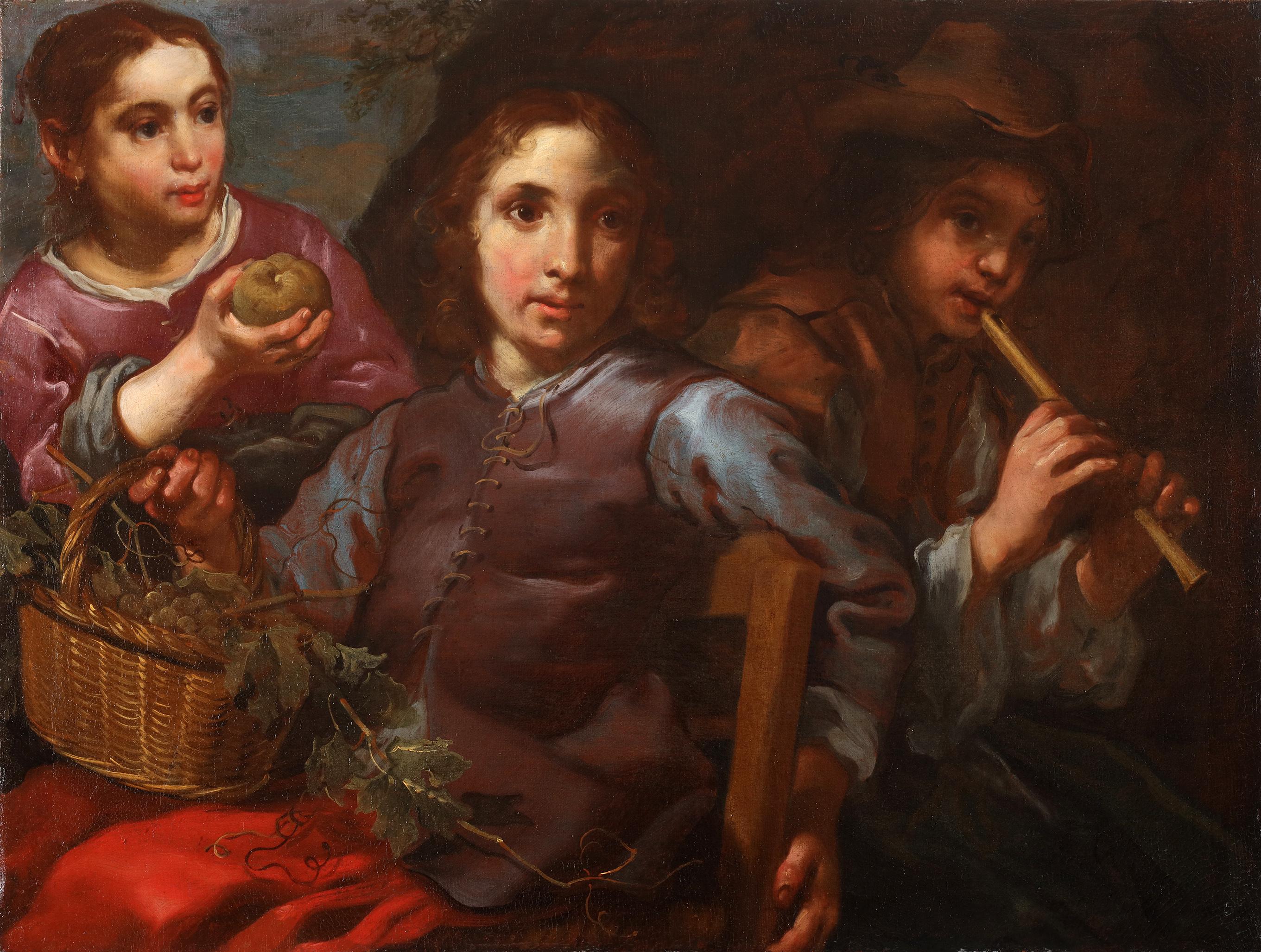Items Similar to The Temptation of Saint Anthony
Want more images or videos?
Request additional images or videos from the seller
1 of 3
Cornelis SaftlevenThe Temptation of Saint Anthony
About the Item
Oil on panel
We'd like to thank dr. Jan De Maere for his advice.
In Cornelis Saftleven's arresting depiction of the temptation of Saint Anthony, the viewer is drawn into a surreal realm where the boundary between reality and nightmare blurs. At the heart of the composition, Saint Anthony, perhaps represented by the humble peasant-like figure in the background, stands as a beacon of virtue amidst a phantasmagoria of malevolent creatures.
Saftleven's canvas pulses with an otherworldly energy, as grotesque amalgamations of animals and skulls loom menacingly, their forms twisting and contorting in eerie dance. Each creature, rendered with a masterful blend of browns and golden hues, exudes a sinister allure, their eyes pools of darkness punctuated by glistening white specks that seem to fixate on the viewer with unsettling intensity.
Born into a family steeped in artistic tradition, Saftleven honed his craft alongside his father Herman and brothers Abraham and Herman the Younger, their collective legacy resonating in the breadth of his oeuvre. While Saftleven's subjects spanned a wide array of themes, from biblical narratives to scenes of everyday life, it was his uncanny ability to conjure visions of hell and allegorical motifs that garnered particular acclaim.
Central to Saftleven's artistic prowess was his virtuosity in capturing the essence of animals, endowing them with a vitality and agency that transcended mere representation. Indeed, in the temptation of Saint Anthony, these creatures emerge as active participants, their presence laden with symbolic significance, hinting at deeper layers of meaning concealed within the enigmatic narrative.
As a draftsman, Saftleven's skill was equally renowned, his black chalk drawings revealing an affinity for single figures and intricate studies of animals, echoing the influence of Roelandt Savery. Yet it is perhaps in works like this haunting portrayal of Saint Anthony's struggle against temptation that Saftleven's singular vision truly shines, beckoning the viewer into a realm where the boundaries between light and shadow, reality and illusion, blur into tantalizing ambiguity.
- Creator:Cornelis Saftleven (1607 - 1681, Dutch)
- Dimensions:Height: 9.85 in (25 cm)Width: 10.24 in (26 cm)
- Medium:
- Movement & Style:
- Period:
- Condition:
- Gallery Location:Gent, BE
- Reference Number:1stDibs: LU2239214415192
About the Seller
No Reviews Yet
Vetted Seller
These experienced sellers undergo a comprehensive evaluation by our team of in-house experts.
Established in 1999
1stDibs seller since 2022
- ShippingRetrieving quote...Ships From: Gent, Belgium
- Return PolicyThis item cannot be returned.
More From This SellerView All
- Portrait of three children - Bernhard Keil (1624-1687)Located in Gent, BE“A portrait of three children, one of them holding a basket of grapes, while another plays the flute” Oil on canvas Housed in a blackened 17th-century frame. We'd like to thank dr...Category
17th Century Old Masters Portrait Paintings
MaterialsOil, Panel
- Peasants smoking and drinking - Gillis van Tilborgh (c. 1625 - 1678)Located in Gent, BEOil on panel Signed lower right At the forefront, a child barely reaching the height of the table, sits upon a modest chair, engaged in her simple meal. Her youthful visage captivat...Category
17th Century Old Masters Figurative Paintings
MaterialsOil, Panel
- Mary Magdalene praying in her caveLocated in Gent, BEImmerse yourself in the serene spirituality and masterful technique of David Teniers the Elder with this evocative depiction of Mary Magdalene in her cave. Trained under the tutelage...Category
17th Century Old Masters Figurative Paintings
MaterialsOil, Panel
- A bird concertLocated in Gent, BEOil on panel We'd like to thank dr. Jan De Maere for his advice. The exquisite detail and vibrant composition of this painting attributed to Jan Baptist Bouttats, show a versatile ...Category
17th Century Old Masters Animal Paintings
MaterialsOil, Panel
- A praying elderly woman by Quiringh Van Brekelenkam (1622-1669)Located in Gent, BEOil on panel Signed and dated lower left. Quiringh van Brekelenkam was a Dutch genre painter, who studied under Gerard Dou. As a result, his paintings from the 1640s and 50s are si...Category
17th Century Old Masters Portrait Paintings
MaterialsOil, Panel
- The PipesmokerLocated in Gent, BEImmerse yourself in the charm of Dutch Golden Age artistry with this captivating piece by Edward Collier, an acclaimed still-life painter renowned for his vanitas and trompe-l'œil wo...Category
17th Century Old Masters Figurative Paintings
MaterialsWood Panel, Oil
You May Also Like
- Portrait of Gentleman, Thomas Bruce, Earl of Elgin c.1638 Manor House ProvenanceLocated in London, GBTitan Fine Art present this picture which formed part of a historic collection of an English aristocratic family, Lord and Lady Sandys at their magnificent baroque and Regency Grade-...Category
17th Century Old Masters Portrait Paintings
MaterialsOil, Wood Panel
- Portrait of a Lady Diana Cecil, Countess of Elgin c.1638, Manor House ProvenanceLocated in London, GBTitan Fine Art present this picture which formed part of a historic collection of an English aristocratic family, Lord and Lady Sandys at their magnificent baroque and Regency Grade-...Category
17th Century Old Masters Portrait Paintings
MaterialsOil, Wood Panel
- River Landscape with a Windmill and ChapelBy Jan Josefsz Van GoyenLocated in Palm Desert, CA"River Landscape with a Windmill and Chapel" is a painting by Dutch Old Master Painter, Jan van Goyen. There are traces of a signature on the bow of the boat...Category
1640s Old Masters Landscape Paintings
MaterialsPanel, Oil
- 16th Century by Venetian Maestro Deposition of Christ Oil on PanelLocated in Milano, LombardiaFormerly Canesso Collection, Paris. Publications: Bozzetti, modelletti, sketches: dalla collezione di Giorgio Baratti (From the Giorgio Baratti Collection) curated by Anna Orlando, ...Category
16th Century Old Masters Figurative Paintings
MaterialsOil, Wood Panel
- Portrait of a ManLocated in New York, NYProvenance: with Leo Blumenreich and Julius Böhler, Munich, 1924 Dr. Frederic Goldstein Oppenheimer (1881-1963), San Antonio, Texas; by whom given to: Abraham M. Adler, New York, un...Category
16th Century Old Masters Portrait Paintings
MaterialsOil, Panel
- Portrait Gentleman Black Coat Orange Sash, Dutch Old Master, Oil on Panel c.1650By Bartholomeus van der HelstLocated in London, GBThis exquisite portrait of a gentleman depicted in a sumptuous black coat edged with silver and slashed sleeves is an excellent example of the type of portrait fashionable in England and the Low Countries during the 17th century. The confident pose, striking orange sash - the colour of the house of Orange Nassau - and the leather gorget imbue the sitter with a sense of masculinity and power. The profusely decorated costume is of the highest quality and de rigueur of an elite class - the artist has carefully cultivated this portrait to emphasise the sitter’s wealth and standing in the society that he belonged to. The casual pose, with one arm resting on a hip, is much less formal than earlier decades, and it speaks of ‘sprezzatura’ – one’s appearance should not appear laborious, but instead, effortless. The oil on cradled panel portrait can be dated to circa 1650 based on the hairstyle and the attire - small falling collar, short doublet (doublets reduced in size to just below the ribcage in the late 1650’s), and the type of slashed sleeves with the sleeve seams left open to reveal the white fabric. The demand for portraits in the Netherlands was great in the 17th century. Bartholemeus van der Helst was considered to be one of the leading portrait painters of the Dutch Golden Age surpassing even Rembrandt as the most sought-after portraitist in Harlaam. The Dutch Golden Age, roughly spanning the 17th century, was a period when Dutch trade, science, military, and art were among the most acclaimed in the world. Dutch explorers charted new territory and settled abroad. Trade by the Dutch East-India Company thrived, and war heroes from the naval battles were decorated and became national heroes. During this time, The Dutch Old Masters began to prevail in the art world, creating a depth of realistic portraits of people and life in the area that has hardly been surpassed. The Golden Age painters depicted the scenes that their discerning new middle-class patrons wanted to see. This new wealth from merchant activities and exploration combined with a lack of church patronage, shifted art subjects away from biblical genres. Still life’s of items of everyday objects, landscapes, and seascapes reflecting the naval and trade power that the Republic enjoyed were popular. The new wealthy class were keen to have their portraits commissioned and many artists worked in this lucrative field. Such was the popularity of art that everyone had a painting, even the humble butcher, and hundreds of thousands of paintings were produced. By tradition the sitter is Maarten Tromp (1598-1653) who was an Admiral in the Dutch Navy (the reverse of the portrait contains an old handwritten inscription “van Tromp”). Certainly, the distinctive orange sash is similar to those worn by officers of the Dutch army in the Netherlands who served under the Princes of Orange and the House of Nassau. However, it should be noted that the physiognomy differs from other images of Tromp. Tromp was the oldest son of Harpert Maertensz, a naval officer and captain. He joined the Dutch navy as a lieutenant in July 1622 and was later promoted from captain to Lieutenant-Admiral of Holland and West Frisia in 1637. In 1639, during the Dutch struggle for independence from Spain, Tromp defeated a large Spanish fleet bound for Flanders at the Battle of the Downs, which marked an enormous change - the end of Spanish naval power. He was killed in action during the First Anglo-Dutch War in 1653 where he commanded the Dutch fleet in the battle of Scheveningen. Gloves were an absolutely vital accessory and the elaborate pair in this portrait are embellished with threads of silk and precious metals and salmon-coloured lining. He wears only one glove and holds the other, providing an opportunity to better display the cuffs and detail on his right wrist and forearm. The gloves are probably made from the most prized leather which came from Spain, in particular from Cordova. Cordovan leather was tanned with a special vegetal process that left it both highly impermeable and divinely soft. King Charles I, posed in a rather relaxed manner for Daniel Mytens’s portrait in 1631, is wearing gloves and boots in matching Cordovan leather. The hide is thick, but you can see just how supple it is from the way the gauntlet dimples and the long boot legs fold over themselves, rippling and wrinkling at the ankles. Apart from keeping hands warm the use of gloves during the 15th through the 19th centuries were full of symbolism and they were worn regardless of the season. They kept the skin unblemished - soft, smooth hands were considered highly attractive. This combination of necessity and proximity to bare skin made gloves a deeply personal gift and they took on a strong symbolic significance and were regarded as emblematic of fidelity and loyalty for hundreds of years. Such was the importance of their symbolism was that some gloves were never intended to be worn at all. Their luxury made them ideal gifts at court, and so in the 15th and 16th centuries, ambassadors often presented them as symbols of loyalty. Until the mid-19th century, it was customary to give gloves as tokens to guests at weddings and to mourners at funerals. Gentleman often gifted their bride-to-be with a pair of gloves (the obligatory gift) and were handed over at the betrothal and put on display before the wedding took place. It was probably their direct contact with the skin that led to the eroticism of gloves. Not only were pairs often exchanged between lovers, but from the 16th to the 18th centuries, it was common practice to remove one glove and give it as a gift to a favourite. The idea of the item being presented still warm from the wearer’s hand is certainly suggestive. Following the death of King George IV, his executors purportedly found over a thousand mismatched ladies’ gloves among his possessions. The sentiment of a 17th-century poem reveals the popularity of the practice: “Come to our wedding to requite your loves / Shew us your hands and we’ll fit you with gloves.” Such generosity might be pricey for the hosts, but gloves of varying quality could be offered depending on the status of the recipient. Pairs made with the finest Spanish leather might be reserved for immediate family, while coarse sheep’s leather could be distributed among the servants and tradesmen. The apportioning of quality according to class provided a very clear message of the gloves’ intended use. For refined guests, they were decoration; for the lower classes, they were functional. Bartholomeus van der Helst...Category
17th Century Old Masters Portrait Paintings
MaterialsOil, Wood Panel





